The XV Patrick Blackett will be used as a trial ship, experimenting with new technologies including drones.
Last month I reported that the new ‘Special Purpose Vessel’ would arrive in Portsmouth to be prepared for her role as a trials platform. That has now happened.
Image credit to the excellent RNPics on Twitter. You can click here to follow them.
As I reported previously, the vessel was procured through a £9m contract and will support trials for “autonomy development”.
Presenting the XV Patrick Bleckett 'X01', a new ship delivered to the Royal Navy to support trials of autonomous systems such as drones. The vessel was purchased as part of a £9m contract. Image via @RNPics_. pic.twitter.com/9D2TLSz8Nq
— George Allison (@geoallison) July 27, 2022
The contract specifications describe a steel vessel with a draught of 3.5m, top speed of 20 knots, a range of 2500 nautical miles, a crew of 6 and the ability to tow small boats such as RHIBs. In addition, the vessel is expected to accommodate 2×40 foot ISO containers or 2x 20-foot ISO containers.
While the vessel will also be expected to be autonomous in future, the contract specification makes clear that it will not be for some time “the functional integration of technology provided to enable the autonomous behaviours of the platform are excluded from this current contract but that the contractor should support the physical integration of this equipment in future”.
The statement of requirements is relatively vague but does state that NavyX (that’s the part of the Royal Navy that operates this vessel) require a small ‘Fast Crew Vessel’ style ship to serve as a testbed and trials ship for the Royal Navy.
What’s the list of specs?
| The vessel should not have had any previous owners other than the vessel’s builder (or other owner while vessel is in build only). The vessel should already exist and be suitable for ownership to transfer in the timelines given below. |
| Vessel length less than 48m LOA |
| A speed of 20 knots be achievable in light displacement |
| A fuel range of 2500 nautical miles at most efficient speed should be achievable |
| Vessel to have a gross tonnage of less than 500 GT. |
| The vessel should have a maximum draft of 3.5m. |
| The vessel can berth and unberth unaided from its nominated berth. |
| The vessel should be capable of towing small vessels (such as 12m RHIB). |
| The vessel’s primary machinery (prime movers, gearboxes, rudders etc) will where possible be controlled using digital interfaces. |
| The vessel will have a digital autopilot system. |
| Primary hull structure should be steel. Other materials can be used elsewhere in the vessel (for example superstructure). |
| The vessel be able to provide electrical power to the aft deck. |
| The vessel be able to be modified to provide fresh water to the deck. |
| The vessel be able to be fitted with a crane suitable of lifting 3.5 tonnes at 4.5m of distance. |
| The working deck be at least 120m2. |
| The working deck be able to accommodate 2×40 foot ISO containers or 2x 20-foot ISO containers. |
| The vessel is to have an open stern of suitable strength for the deployment of vessel appropriate equipment over the stern. |
| The working deck shall have a load carrying capacity of at least 2 tonne/m2. |
I’m waiting to here more about what the actuals pecs are and how closely they match the requirements above.




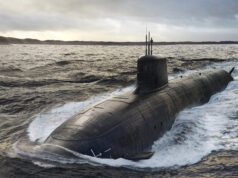
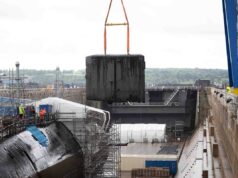
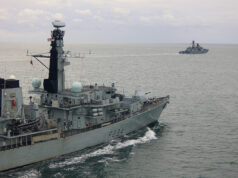
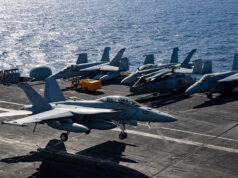

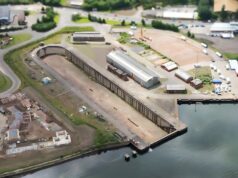
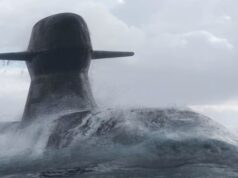


But where has the ship arrived from? Or have I missed something? Interesting concept, but longer term need to be building this in our back yard….
What I thought and such an unusual specification..
Direct from Damen in the Netherlands. They pretty much have them ready built in stock.
Similar to SD EVA that was disposed of a few years ago.
This sounds like a lease, rather than a purchase. 9 million seems a bit light
So it could mean that the maintenance of the ship is part of the deal.
Once again, Britain fails to count the cost of de-skilling it’s workforce in favour of a a perceived ‘cheap Option’.
And… Don’t forget, it’s only three hundred and fifty odd years ago since the Dutch came up the Thames and burnt some of our ships!!! 🙂
Only Damen tendered. We don’t need to be building these ourselves, it’s a trials platform, not a warship.
This point is one of my ‘totally agree with’ – if something is readily available off the shelf, isn’t something it’s strategically necessary to control the construction of, and cheaper to buy this way – do it. We need to prioritise control on building things of strategic or economic importance.
I disagree and will use the excellent Damen as an example
Damen build ships all the time (whether they are sold or not) and keep their yards busy – they always have stock of the simpler platforms
The RN/MOD/HMG have a requirement for circa 2.5k smaller vessels (lets say sub 50m). which means we do have enough need to keep a yard busy building 100 vessels per year indefinitely.
Add in commercial vessels and there is a market for perhaps another 20-50 vessels pa.
This could be used to keep a specialist yard going (Appledore) or to keep key yards constantly busy and build up skills through constant work.
Damen are excellent, their model is great as are their designs. I have no problem with the UK buying from them, but at the same time we need to learn from them as well.
the same can be applied to railways as the uk has a rolling stock of 25,000 units – so 1k new per year indefinitely. bringing this all together then means we can support our steel industries etc… especially if we link in with our car and land vehicle strategies.
We need a national, integrated plan that joins all of these things up.
Indeed, and the offshoot would be lower cost to the UK tax payer as more are built…
It’s one of those weird times when I can also agree with you!
OK, Why?
Firstly, we can’t do everything. There are a lot of markets available – but how many can we afford to compete in? Specialist yard? Would it be a specialist yard producing things we need and that could cause problems if we don’t control the whole lot? Go for it!
But – if we have a need for large numbers of readily available off-the-shelf items that are not going to be a choke point – can we produce them as well or as cheaply as others can? Your Damen example is a good one – but would there be space for us to compete? Same with rail stock. We do need to produce things ourself – but we need to decide which ones are worth the extra costs involved.
After all, you can extend it to fridges, freezers, microwaves – mostly imported because others produce them cheaper. As I said, to put taxpayers money in (and that is what it involves) we have to prioritise.
Tanks? I would import. Warships? Home built including as many of the potential chokepoint as possible. Aircraft? Love to be able to do everything, but how practical? Here, we need partners.
👍👍
Yes and this was readily available, off the shelf, and isn’t a strategic asset, hence we don’t need to be building vessels like this.
We must keep and grow these skills and resources in the UK. To buy this from Europe is just stupidly eroding our economy.
The excellent Navy Lookout has an in-depth article on the XV Patrick Blackett; https://www.navylookout.com/royal-navy-takes-delivery-of-new-experimental-vessel/
Newly built by Damen in the Netherlands as a Offshore Tug/Supply Ship. Gross tonnage 270. Length 40m Beam 8m. Draught 2.3m
The colour scheme reminds me of the Black pig
Those were the days 40 yrs ago Farouk chugging round Stanley
I didnt chug I sped in my Combat Support Boat
Farouk some of my Oppos crewed the Blackpig in July 82 she chugged around Stanley Harbour not your top of the range Jet boats sorry for the cross wires
No offence taken, we were the fastest things in the water and everybody chipped in, in which to help others. If i had a trip to the outer harbour, I was always given a meal by the crew of the ship, the Navy gave us beer and the Marines…Rum. The infantry and RA always friendly and we ensured that they were jumped to the front of any queue in which to get them to their pits. (usually after a long stag) The only people I ever got hassel off was from the Royal Engineers , the same cap badge I wore. Funny that.
🚣♂️ Blackpig 🚤 CSB 👍
showing your age again young man!!!
That I am
Where’s the 5inch gun ? The MK41 VLS ? The double hanger for F35 ? The Photon torpedoes ? The plasma cannon ? FFBNW strikes again.
😐😐
I believe the second hand on the bridge clock is dual purpose …
Now you’re just being silly. 😁
After a number of years not bothering, I just read a comments section on the BBC News website. I will never call anything on this site silly again.
Jon
Just try the DT online community. Barking. You couldn’t make it up 🙂
Yeah but it’s even worse. 9 times out of 10 when people are silly on this site it’s deliberate.
May the farce be with you.👽
Luke the farts is strong with this one. 😂😂
A very good analysis on how the ship was required
https://www.navylookout.com/royal-navy-takes-delivery-of-new-experimental-vessel/
Cheers James an interesting read. A couple things strike me though, a 3 ringer as the ‘big dipper’ and with such a small crew, who’s going to do the scrubbing out. 🤔
I imagine that they would do the same as the crews did on MTB’s etc etc etc, during WWII, because they had small crews of four to six on average didn’t they???
MTB’s weren’t really going to sea for extended periods and weren’t really designed to be ‘lived in’, I’d suggest the P2000’s would be a better analogy. If you’re going to be at sea for even a week, things need cleaned (guess I’m indoctrinated 😋) and this is quite a size for a small crew. They’ll maybe save it up for getting alongside and get some inboard types to do it, dunno but the navy is fond of the whole scrubbing out and ’rounds’ thing.
Could this be used to experiment with making a ghost fleet?
Won’t be a commissioned vessel apparently, but under the blue ensign.
just goes to show that we don’t know what the military get up to, and the experiments that are on going,
good job,
wonder what next will be revealed ??
The RNs requirement for this was reported a while ago.
Indeed lots of things we are not privy to, that is the domain of DSTL, UKSF, BAES SPS, and the UK Int community.
Whats baes sps?
Sorry, the Special Projects Site at BAE Warton.
Look on Google Earth and its the cluster of buildings to the south east side of the airfield.
Our version of Lockheeds Skunk Works and classified programmes conducted there, way back to the mid 90s and the first UAV prototypes which were said to land at remote places like West Freugh.
Open source info btw.
thanks for that
Had to look up Patrick Blackett.
Please enlighten me. Who is this dude
British 20th century physicist and Nobel prize winner. I know he worked on cosmic rays, a quick search says he also researched paleomagnetism (history of the position of magnetic fields) and cloud chambers (used to study ionising radiation). He also served in the RN and developed technologies that helped defeat German boats, as well as analysing RAF tactics and results and finding inefficiencies. Might be a hint to the sort of things that the RN and armed forces as a whole are looking at right now.
That’s interesting. I assumed it was someone from 200+ years ago that won a battle or did something good. I will have a read up about them now.
He was a midshipman at the Battle of the Falklands and a subbie at Jutland, later a lieutenant on destroyers. From 1941-5 he was Director of Operational Research for the Admiralty, responsible for the RN’s data collection and analysis to develop weapons and tactics for the Battle of the Atlantic (this gives a hint about the ship’s role, I guess).
He is on Wikipedia.
Got to love the Olympic Class shaped prow.
..and the Ukraine Flag flying in the background
She looks like she would be the perfect small support vessel for our modern way of dealing with mine problem rather that stick them on big warships which will only be a bigger target when stationary. Although noted a Cdr is noted as the Commanding officer, bit of an over kill really when a CPO could deal with it easily.
Don’t you think this reflects the tasks the vessel will.undertake?
Fully aware of the tasking as a for the team she is assigned too being an experimental group. I just said a similar vessel would be ideal for getting the new MW systems to where they are needed rather than a full blown warship.
My comment was in response to your comment on the rank of the o/c
May be the nominated CO of its tasking rather than at the wheel me thinks. But noted thanks.
I think they need a modern Q boat type design for the rmc and a couple of””tubes””on the side.they shouldn’t take “”shit”” drug runners.a pop up Q gun and autononoumous engagement for drug runners and mother ships would put them in charge of such nefarious activities.
RM already have such a craft.
Really should be building this ourselves.
With the specifications given, No previous owners ect, yet we purchase abroad.
Why not just go all out and ask Putin for any platforms.
No disrespect to the Dutch, If that is were it came from.
But we really should be open to giving contracts for this size/specific design of craft to home companies. Or when fully operational we just sell to war torn country’s, Instead of keeping our tech secret. 🤔🤷🏻♂️
Err, this sort of reverse specification goes on. Client decides what they want, but it can only be procured through a ‘competitive’ contract. So from the desired item is produced ‘the spec’ in such a way there is only going to be one serious bidder. Somewhat inefficient way of buying, but the process confirms to competition rules. Whilst Appledore would like such contracts but it would have no realistic chance of winning. In fact procurement would have been surprised if anyone else tendered. Happens all the time.
They wanted this quickly. The only requirements other than the spec of the vessel were that it be already built but not pre-owned, and of course from a reliable and trusted partner. There was no need for some custom design.
Damen were the only ones who bid too.
I don’t know of any shipyards in the UK that could deliver this in a year.
Takes me back 25-30 years ago to the RN trialling the RV Triton. A lot of activity … and after a few years it got sold-off. … And absolutely nothing, nothing at all, was used going-forward (although fair enough if what was learned was undesirable).
Triton spent a long time hanging around in the port of Great Yarmouth. Working as a survey vessel apparently. That was 5+ years ago now so don’t know if its still there or not.
Wiki has the info. After a trip to Aus as a customs cutter for a few years she is back in the UK and tied up in Hull.
Where does ‘XV’ come from? I thought the RN used ‘RV’ for ‘Research Vessel’ like the Triton.
How can a deck with a load capacity of ‘in excess of two tons, be able to handle two 40′ containers’?